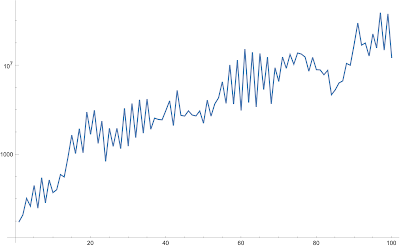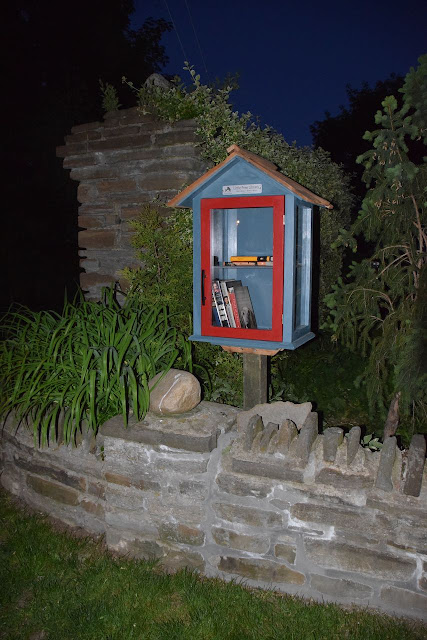Happy New Year!
Sunday, December 31, 2023
Saturday, December 30, 2023
First digits after the decimal point
Éric Angelini is not at the moment updating his latest sequence suggestion, so I will post my extension (assuming a 1, 2 start) here:
1, 2, 11, 5, 42, 4, 94, 7, 74, 20, 27, 129, 101, 777, 7618, 1124, 14753, 1218, 82554, 8156, 98795, 3206, 32451, 499, 15377, 2366, 15386, 1868, 121402, 2419, 199254, 5819, 292038, 9247, 316636, 13812, 43621, 38327, 36725, 95818, 260900, 20134, 771711, 58457, 54269, 92835, 60177, 55065, 91504, 25771, 281635, 53566, 190196, 355062, 1866812, 199551, 10689395, 186879, 17482653, 95960, 54888692, 216986, 39532004, 138119, 34938527, 829143, 23731481, 189726, 7994697, 1908167, 23867906, 7480187, 31339937, 11404557, 36389852, 32664599, 23949435, 5535335, 23112591, 6504115, 6357184, 3851878, 6059094, 489221, 807416, 1650409, 2044061, 12385171, 10283218, 83028464, 807417055, 82135674, 101726454, 26620507, 261687159, 61339564, 2344003581, 48771083, 2080674423, 22994000, ...
 |
| click to enlarge |
Thursday, December 21, 2023
Wednesday, December 13, 2023
A million-digit Leyland prime (third one)
After my second find, I really did not think that I would generate another example in my current search space. However, at the upper end of that space:
194968^136197+1*136197^194968 is 3-PRP!
This is now the 14th largest-known Leyland prime. Ryan Propper owns the largest 13:
 |
| 19 million-digit Leyland primes (via Norman Luhn); n-th Leyland + 1 = A076980 index |
Bucket list #1
My original five-piece bucket list is here with #2 here.
1. Wiener schnitzel (The Coffee Mill closed in 2014; Amber closed in 2021.)
 |
| Café Polonez: 195 Roncesvalles Ave |
 |
| schnitzel with cole slaw, beets, carrots, and potatoes: $21.95 plus tax |
Wednesday, December 06, 2023
Neheim-Hüsten street view
Three years ago I wrote an article about my Neheim birthhouse, captured from a distance on a bicycle-ride YouTube video. In it, I bemoaned the absence of Google's street view. Today, by chance, I noticed that Google has (from October 2022) a very limited street-view coverage of Neheim (and its 1950s-era twin town of Hüsten):
 |
| baby-blue roads have street view: click to enlarge |
I was fortunate that my birthhouse was visible from Bergheimer Weg (in that 2009 blog post is a link to a 1934 photograph of the house being built):
 |
| Bergheimer Weg 16, October 2022 |
Tuesday, November 21, 2023
Swap
Éric Angelini's blog post last Friday (Underline, reproduce) motivated me to attempt to solve
S9 = ninth, twentieth, thirtieth, fourth, ninetieth, sixth, seventh, eighth, ...
... wondering how many swaps (of "first, second, third, fourth, fifth, sixth, seventh, eighth, ninth, tenth, eleventh, …") were needed to produce it. It stymied me for a day or so but (using a combination of manual and Mathematica step-throughs) I eventually got this:
S9 = ninth, twentieth, thirtieth, fourth, ninetieth; sixth, seventh, eighth, first, tenth, second, twelfth, fifteenth, thirtyeighth; thirteenth, fifth, eleventh, eighteenth, nineteenth, seventeenth, twentyfirst, twentysecond, fourteenth; twentyfourth, twentyfifth, twentysixth, twentyseventh, twentyeighth, sixteenth; third, thirtyfirst, thirtysecond, thirtythird, thirtyfourth, thirtyfifth, thirtysixth, thirtyseventh, twentythird; thirtyninth, fortieth, fortyfirst, fortysecond, twentyninth; fortyfourth, fortyfifth, fortysixth, fortyseventh, fortyeighth, fortyninth, fortythird; fiftyfirst, fiftysecond, fiftythird, fiftieth, fiftyfifth, fiftyfourth; fiftyseventh, fiftyeighth, fiftyninth, sixtieth, sixtyfirst; sixtysecond, sixtythird, sixtyfourth, sixtyfifth, fiftysixth; sixtyseventh, sixtyeighth, sixtyninth, seventieth, seventyfirst, seventysecond; seventythird, seventyfourth, seventyfifth, seventysixth, seventyseventh, seventyeighth, sixtysixth; eightieth, eightyfirst, eightysecond, eightythird, eightyfourth, eightyfifth, eightysixth, eightyseventh, seventyninth; eightyninth, eightyeighth, ninetyfirst, ninetysecond, ninetythird, ninetyfourth, ninetyfifth, ninetysixth, ninetyseventh, ninetyeighth, ninetyninth, onehundredth; ...
In case you are still wondering what this is all about, the sequence of written-out ordinals reproduces itself if you take its 9th, 20th, 30th, 4th, 90th; 6th, 7th, 8th, 1st, 10th, 2nd, 12th, 15th, 38th; 13th, etc. letters. I have replaced commas with semicolons where the spelling of each ordinal ends. The semicolon after "onehundredth" indicates the end of "thirtyeighth".
So I told Éric that there were 24 swaps, i.e. red-lettered ordinals (where the number does not correspond to its position in the sequence). But in my mind "swap" has a strong sense of pairwise exchanges, which is not the case here. There are three such pairwise exchanges: Positions 1 with 9, 3 with 30, and 13 with 15. But the rest are more involved. Position 14 goes to 38, which goes to 23 (which goes to 14). Position 2 goes to 20, which goes to 17, which goes to 11 (which goes to 2). Finally, position 5 goes to 90, which goes to 88, which goes to 79, which goes to 66, which goes to 56, which goes to 54, which goes to 50, which goes to 43, which goes to 29, which goes to 16 (which goes to 5).
Update: I've calculated 11001 indexed terms for
S10 = tenth, eighteenth, twentyeighth, ninetieth, fifth; second, seventh, eighth, ninth, first, sixth, eleventh, eleventhousandth, fourth, fifteenth; fourteenth, seventeenth, twelfth, third, sixteenth, twentyfirst, twentysecond, twentythird, twentyfourth, twentyfifth, twentieth, twentyseventh; ...
In the linked file, the 1098 red entries are indicated by an asterisk at the end of the line.
Monday, November 20, 2023
Tuesday, November 14, 2023
Doctor in the Tardis
After a decade-long hiatus of not seeing my family doctor, on September 27 I had my first appointment with a new doctor. After taking down some of my personal information we agreed to my doing a blood test and an Ontario Health fecal immunochemical test. In an October 13 phone appointment, he relayed the bad news: My cholesterol was high, which when combined with my family history of stroke (my father had one) suggested medication. When I indicated reticence to go on meds he allowed me a three-month reprieve of diet and exercise followed by a retest. To add insult to injury, the fecal test proved abnormal, inviting a colonoscopy. I suggested that the result was a false positive based on contamination with hemorrhoidal bleeding.
So I spent a month researching the matter and, this afternoon, saw him in order to share my findings. I decided ahead of time not to get into the family-history-of-stroke matter which I saw as confirmation bias on his part (he didn't even know at what age my father had the stroke). The diet-and-exercise bit is of course something to be suggested regardless (as it is generally worthwhile), not as a designed-to-fail antidote to statins. I wasn't going to get into that either as it evidenced a desire to get me on meds and I didn't want to be confrontational. At any rate, the matter was moot as I had found sources that suggested (in the absence of cardiovascular disease, diabetes, etc.) that I had no need to be on meds.
First, I presented Dr. Ian Neeland's (22 Dec 2020) podcast quotation of "10 years on a statin with low LDL cholesterol might decrease your risk [of heart attack, stroke, etc.] by 20 percent" as being (for me) a negligible benefit. Next, I presented Robert M. Kaplan's (3 Apr 2019) opinion piece on preventing heart disease, starting with some absolute risk-of-dying meta-analysis statistics and concluding with "... observations on people over the age of 70 do not show any statistically significant statin-related reductions in deaths from any cause."
Throughout most of the session my doctor seemed overly defensive, mildly angry perhaps. He interrupted me several times, explained that he was following guidelines, and cautioned me on cherry-picking data. He closed the door to the hallway at one point. Much more was said but I choose here to be brief.
I had run out of my 15 minutes and I hadn't yet dealt with the fecal test. I asked for a couple more minutes. I explained my false-positive belief, suggested that it didn't matter anyways because I had "a very low long-term risk of colorectal cancer" based on a (19 Sep 2013) study on long-term colorectal-cancer incidence and mortality. I finished with Michael Bretthauer's "gold-standard trial" that had colonoscopies cutting cancer risk by only a fifth with no significant reduction in colon cancer mortality. How do you like them apples cherries?
Saturday, November 04, 2023
New Jersey
Rogue Amoeba has updated their Audio Hijack to version 4.3 and I had been meaning to upgrade my 3.7 app for a while now. Tipping the scale was a "transcribe" block that I thought might prove interesting in attempting the lyrics to Dave Van Ronk's Garden State Stomp. There were two available options for the transcription: high accuracy which, in spite of the lengthy time that it took, proved abysmal, and low resources which, utilizing an AI-based Large Language Module, was just as bad, only with added nonsense.
Places per line are 4/4/12 (times 4 = 80). Lyrics/spelling as per the video:
Allamuchy, Hacklebarney, Rockaway, Piscataway.
Ho-Ho-Kus, Secaucus, Lower Squankum, Fair Play.
Wanamassa, Succasunna, Manumuskin, Plumbsock, Bivalve, Buckshutem,
Turkey Foot, Macanippuck, Jugtown, Febletown, Nummytown, Rahway.
Wickatunk, Manunka Chunk, Mantua, Mizpah.
Manasquan, Raritan, Matawan, Totowa.
Whippany, Parsippany, Penny Pot, Hackensack, Batsto, Nesco,
Metedeconk, Peapack, Loch Arbour, Egg Harbor, Swinesburg, Caviar.
Cheesequake, Boy Scout Lake, Moonachie, Tenafly.
Netcong, Watchung, Pluckemin, Mount Misery.
Bardonia, Ironia, Colonia, Weehawken, Manahawkin, Mantoloking,
Mahalala, Pennsauken, Dutchtown*, Ironbound, Frelinghuysen, Lodi.
Hardscrabble, Double Trouble, Picatinny, Montague.
Muckshaw Pond, Ockanickon, Espanong, Ocean View.
Navesink, Shabakunk, Ongs Hat, Jumbo, Wortendyke, Water Witch,
Blue Ball, Ringoes, Matchaponix, Delawanna, Wawayanda, Timbuctoo.
* which Van Ronk seems to pronounce Ducktown.
Sunday, October 29, 2023
Bucket list #2
My original five-piece bucket list is here with #3 here.
2. China Town (Their online ordering system stopped working a few years ago.)
 |
| 1790 Jane Street @ John Street |
The picture is Google street view (July 2023). I did eventually find another website ordering system for them but I was reluctant to use it in case it was a scam. Researching the website provider (MealKeyway), I decided finally that it was ok.
Pretty much the way I remembered it, although I used to get BBQ chicken wings as well. I hadn't before used a no-onion option on the mixed vegetables. They replaced it with more broccoli which (unfortunately) was excessively salty. I guess the florets/buds retain a lot of the briny broth. I can run them under the faucet in the leftover reheats.
Saturday, October 28, 2023
Tuesday, October 24, 2023
AD one billion
Éric Angelini's latest offering is based on the absolute differences (AD, be they odd or even) of an integer sequence's adjacent digits determining the sequence's new numbers. After Giorgos Kalogeropoulos posted one million terms, I struggled to better his (apparently Mathematica) result to five million terms before realizing that my one-at-a-time AppendTo approach was not the best tool for this game.
Starting with 315 terms of the sequence (s) we generate — in twelve steps — over one billion terms by repetitively determining the adjacent-digits sequence, creating therefrom an absolute differences sequence, and applying a sign change to those differences that are even. Prepend zero, Accumulate, add 10.
Table[d=Flatten[IntegerDigits[s]]; c=Abs[Most[d]-Rest[d]]; f=Prepend[Table[If[OddQ[c[[i]]],c[[i]],-c[[i]]], {i,Length[c]}], 0]; s=Accumulate[f]+10; Length[s], {12}]
{577, 1181, 2719, 6976, 19556, 57525, 203635, 791890, 3733165, 21270116, 140287834, 1002951921}
That's it! Truncate the final 1002951921 terms to 10^9 terms, take every tenth integer (Mathematica has trouble enough plotting 100 million points), and graph:
 |
| click to enlarge |
Thursday, September 28, 2023
Recycling
This is the sixth recycling bin put out for city collection containing mostly old journals and magazines. It was precipitated (literally) by the roof leak that meandered through an upstairs slanted ceiling closet I was using as storage space. Even though I am holding back on my most prized collections, I think it likely that I will contribute another six bins before I am done. Here's a photo of some of the "paper" that has (mostly) already gone:
Sunday, September 03, 2023
Thursday, August 10, 2023
A million-digit Leyland prime (encore)
Tuesday, August 08, 2023
833719/265381
Based on the simple continued fraction of π, its convergents (rational approximations) are: 3/1, 22/7, 333/106, 355/113, 103993/33102, 104348/33215, 208341/66317, 312689/99532, 833719/265381, 1146408/364913, ...
Prime numerators are at position 1, 5, 9, ... Prime denominators are at position 2, 4, 9, ... The ninth convergent therefore has both prime numerator and prime denominator, noted ~2003 in the OEIS. It seems unlikely that we will ever see another such.
I thought it might be useful to have here a listing of the positions of prime numerators (p/) and prime denominators (/p) so as to better assess the rarity of their confluence:
1/
/2
/4
5/
9/
/9
11/
16/
/33
87/
230/
334/
594/
/595
840/
853/
/1127
1149/
/2003
2726/
/3611
3788/
/4356
/6926
7442/
8751/
/25333
/27652
/32395
/37722
42038/
/114199
143753/
...
Thursday, July 20, 2023
A million-digit Leyland prime (I got lucky)
Back in April, I wished myself "better luck" in my current million-digit Leyland prime search. I've won that lottery, so to speak:
191319^170462+1*170462^191319 is 3-PRP!
The number has 1000910 decimal digits. The current top-five Leyland prime leaderboard now looks like this (the first column is the number of digits):
1717671 (1343238,19) Ryan Propper May 2023
1433792 (300102,59935) Ryan Propper May 2023
1268947 (1139148,13) Ryan Propper Jul 2023
1000910 (191319,170462) Hans Havermann Jul 2023
1000175 (218767,37314) Gabor Levai Mar 2023
Monday, July 10, 2023
Trouble above
Saturday, July 08, 2023
Thursday, July 06, 2023
Goodbye landline
My brand new iPhone 13 arrived yesterday. I wasted little time in trudging up to Freedom Mobile (1924 Weston Rd.) in the heat — twice (I didn't bring any identification the first time)! So now I have a cellphone number. This meant that I could lose the "home" phone which I had been using only as a two-factor authentication device. When I called Bell, they dragged out the cancellation process and finally offered me the landline (I'm paying $60 per month) for something closer to $10 per month (if I heard correctly). "Just cancel the fucking phone," I blurted out uncharacteristically.
Wednesday, June 14, 2023
Monday, May 29, 2023
Little free library
Ross and Laurie (beside Denison Park at Lippincott) have set up this very nice "little free library" box in a corner of their place. I should be able to donate a few books from my own mostly-reference library. Not everyone thinks that these things are a good idea.
Friday, May 19, 2023
Agent orange
This late-evening marauder comes as close to being "orange" (especially in the tail) as one might deem possible. Close inspection suggests that the effect might just be a whitened mixture of "brown". A search finds that the descriptive word for it is "erythrism". This particular raccoon paced our back- and side-yards for a half-hour or so before finally climbing the fence into a neighbour's yard. This included ventures onto the back deck and peering into the kitchen door. When I went out in order to scare it away, it was somewhat unconcerned by my approach — perhaps even attracted to it — as though it was tame. This leads me to suppose that it might be suffering from distemper.
Friday, May 12, 2023
A million-digit Leyland prime (ryanp)
Tuesday, May 09, 2023
A million-digit Leyland prime (ramp-up)
This is an update to my previous "retry" post, wherein I announced a new million-digit Leyland prime search attempt. Today I finished ramping up the search from the initial 12 processes on 3 computers (covering 20% of the search space) to 57 processes on 18 computers (covering about 70% of the search space). My search last year had the same 18 machines doing 108 processes but I subsequently discovered that this overloading of processes was highly inefficient and detrimental to the effort. My current 57 processes should all be done (roughly) in early November and I can assign the remaining 30% of the search space — process by process, as they come due — at that time.
Thursday, April 27, 2023
A million-digit Leyland prime (retry)
After my last disappointing attempt, I have started again today on a new search. Initially, I will commit twelve processes (on my fastest three computers) to about 20% of the search space, with a completion date of late October. I'm hoping for better luck this time around.
Thursday, April 06, 2023
Bucket list #3
 |
| 1300 Weston Road |
 |
| 10-piece 'original' bucket; large fries, cole slaw, potato salad: $41.80, which included a $3 charge to guarantee 7 'white-meat' pieces, but I got only 6 (plus a drumstick and 3 wings) |
Tuesday, March 21, 2023
All around my hat
It has been a long time since we were all excited by the aperiodic tilings of Penrose's kites and darts. There was even a version using images of chickens:
 |
| Penrose chickens |
 |
| Brad Klee: headliner |
Monday, March 13, 2023
A million-digit Leyland prime (lghu)
Tuesday, February 28, 2023
A million-digit Leyland prime (start of a new run)
Five days ago I started a new run of testing candidates for the property of being a million-digit Leyland prime. The million-digit part is relatively easy; the primality testing, not so much. My last run required nine months, not counting the month it took to sieve. I'm not pushing it for now. Of the 59364 candidates in this run, I'm only doing 9000 on my three iMacs. This should be done in July. My Mac minis are testing much smaller Leyland numbers (currently ~386750 digits) for primality and I'll keep that going until I exhaust my current crop of sieved numbers in that range. Only then will I divert them to help in the million-digit hunt.
Monday, February 13, 2023
Small-string final non-appearance coincidences in base-ten powers of two
If we look at OEIS A094776, one sees the beginnings of sequences that apply the inherent concept to strings of more than one digit. Keith Lynch suggested the idea (tongue-in-cheek, I thought) on MathFun a few days ago and Maximilian Hasler actually worked out the numbers for strings 10 to 18. I decided to chart a more comprehensive listing...
My results: sorted by strings and sorted by powers of two. There are "coincidences" where two or more strings share the same power of two as their final non-appearance exponent (for example, the two 71s in A094776 for digits 5 and 7). I'll list those here after brief summaries of each n-digit result:
1-digit strings
{71,5}
{71,7}
...
range: 119.5 ± 48.5
average: 1026/10
...
{153,3}
{168,2}
string coincidence
71: {5,7}
2-digit strings
{1300,91}
{1416,07}
...
range: 2399.5 ± 1099.5
average: 215386/100
...
{3493,28}
{3499,95}
string coincidence
2146: {33,48}
3-digit strings
{20589,141}
{20729,713}
...
range: 37290.5 ± 16701.5
average: 28860154/1000
...
{51375,552}
{53992,661}
string coincidences
22044: {024,275}
24486: {404,675}
25305: {410,947}
25440: {317,604}
25668: {442,815}
25704: {123,766}
25980: {096,868}
26046: {378,588}
26136: {422,677}
26316: {227,929}
26477: {152,690}
26695: {085,256}
26792: {048,732}
27003: {737,974}
27121: {545,932}
27479: {183,687}
28196: {300,554}
28252: {116,641}
28270: {099,575}
28317: {578,656}
28425: {287,392}
28532: {171,910}
28609: {017,919}
28784: {033,719}
28850: {164,647}
28891: {346,505}
29173: {648,787}
29705: {668,997}
29711: {335,799}
29976: {665,995}
30977: {131,395}
32637: {076,426}
33550: {555,796}
33607: {582,598}
33631: {117,735}
39571: {021,622}
Tuesday, February 07, 2023
Fenestron
The loud sound of a helicopter just before 10:30 p.m. last night got me to look out the window and, because of the unusual appearance of the tail, run to get my camera and take a photo from the front porch. The aircraft disappeared behind the apartment buildings on Weston Rd. — seemingly landing (in the vicinity of Weston's UP Express train station; I'm going to guess at the Toronto Paramedic Services lot). Coincidentally, a UP Express service alert appeared one-and-a-half hours later.
Friday, February 03, 2023
Lake effect
 |
| click to enlarge |
 |
| click to enlarge |
Sunday, January 29, 2023
Wednesday, January 25, 2023
A million-digit Leyland prime (end of run)
 |
| manual distribution worksheet for 59536 primality tests |
What have I discovered? Of Leyland numbers with at least one million decimal digits, but fewer than one million one hundred decimal digits, there is only one prime. That prime was discovered by Gabor Levai long before I got to it. I saved all of my primality-test output where the 59536 entries are listed smallest to largest. If you want to see the one prime, search for "PRP".
The execution times vary wildly (due to processor circumstances) with an average of 9.45 hours per test. That would work out to 64 years if I hadn't been able to multi-process. I know now how to keep the execution times to 6 hours or less per test but that means running fewer processes per machine. Still, I might be able to shave a couple of months off the total time required for the next run.
Thursday, January 12, 2023
A digit-spine sequence
Éric Angelini presented a proposal for three "digit-spine" sequences on his blog here, as well as to the MathFun community. I decided to take on the first one:
s = 1, 10, 2, 0, 3, 26, 9, 119, 532, 4, 6, 896, 118, 34, 15, ...
p = 2, 11, 2, 2, 3, 23, 7, 113, 523, 3, 5, 887, 113, 31, 13, ...
d = 1, 1, 0, 2, 0, 3, 2, 6, 9, 1, 1, 9, 5, 3, 2, ...





















